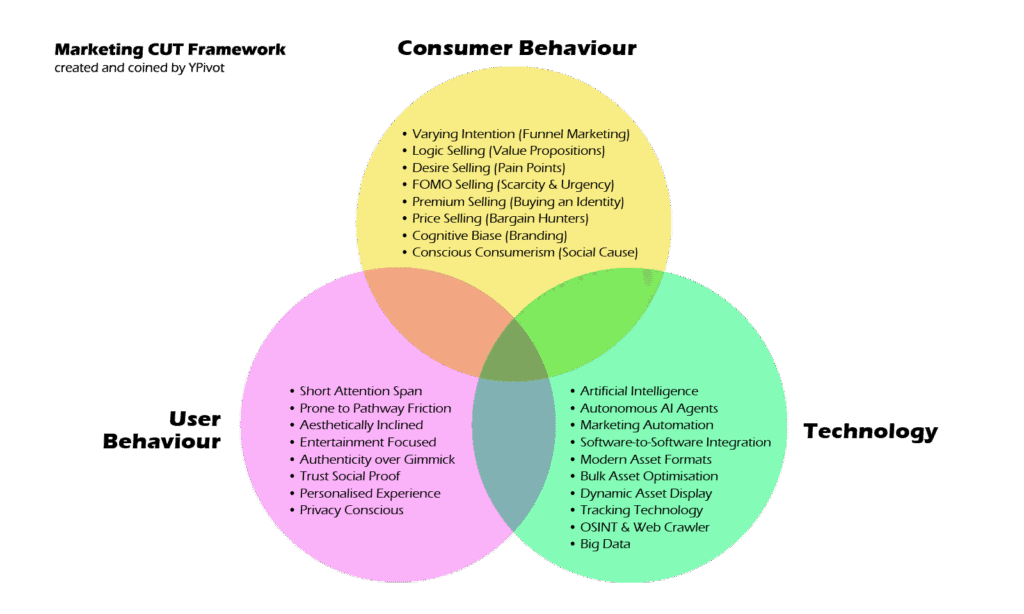CUT Framework: Consumer Behaviour, User Behaviour and MarTech
The Moving Pieces of Modern Marketing
Marketing is constantly evolving, shaped by three ever-shifting forces: Consumer Behaviour, User Behaviour, and Technology (Marketing). Together, these elements form the CUT Framework—a lens through which we can better understand the dynamic nature of modern marketing. As consumer values shift, user expectations evolve, and technology rapidly advances, marketers must continuously adapt to stay relevant and effective in an increasingly complex landscape.

Consumer Behaviour
In the digital era, marketers can target audiences based on their position in the buyer journey, whether they’re at the awareness, consideration, or conversion stage of the marketing funnel. However, many marketers fall into the trap of using a one-size-fits-all approach across the funnel. For example, running conversion ads with vague, stylised copy that lacks a clear value proposition, or pushing hard-sell CTAs and promotions in social posts meant to build brand awareness.
Price selling is often seen in a saturated market. When a product lacks differentiation and is widely available in the market, price becomes the key lever — marketers must rely on creative promotions and discounts to stay competitive. This price-driven approach can only be sustained if the business has structural advantages like economies of scale or cost-effective offshore production.
Premium selling is rooted in uniqueness and perceived value. Products that are distinct, well-developed, and constantly improved through R&D can command higher margins while elevating the customer’s sense of status. For such brands, restraint in promotional campaigns is crucial, as over-discounting can erode the premium perception.
Modern consumers expect brands to stand for more than just profit—they want purpose. According to a 2023 NielsenIQ report, 78% of global consumers say a brand’s sustainability practices influence their purchasing decisions, and 66% are willing to pay more for products from companies committed to social and environmental responsibility. Additionally, a 2022 Deloitte study found that nearly 1 in 3 consumers have stopped purchasing from brands that don’t align with their values, particularly around climate impact, ethical sourcing, and fair labor. In this era of conscious consumerism, aligning your brand with meaningful causes and sustainable practices isn’t just good ethics—it’s good business.
User Behaviour
Audiences now have shorter attention spans, demanding concise, impactful content — a shift that has driven the rise of short-form videos over traditional long-form storytelling. The first three seconds are critical, and must deliver a strong visual or narrative hook to stop the scroll and hold attention.
Consumers increasingly seek entertainment in marketing, but brands must balance fun with purpose. Chasing mindless trends like “Skibidi Toilet” may drive views but risks weakening brand credibility. On the other hand, many brands play it too safe, avoiding entertainment altogether out of fear of damaging their image — resulting in dull, forgettable content that gets buried among competitors and performs poorly on social platforms.
Trust is no longer built through polished ads alone, but through authentic social proof, with testimonials and user-generated content playing a central role in shaping brand credibility. Marketers who can design smart incentives for customer reviews or implement automated pipelines to streamline the collection process will significantly amplify brand impact and trustworthiness.
Audiences today are highly sensitive to pathway friction, and one of the biggest culprits is slow website load speed. A delay of even a few seconds can result in huge visitor bounce off and a significant loss in lead generation. This makes technical know-how in assets, code, tags, and server optimisation a vital skill for modern marketers.
Users appreciate personalised experience, but growing concerns around data privacy mean brands must tread carefully. According to a 2023 Salesforce report, 73% of consumers expect companies to understand their needs, yet 61% are uneasy about how their data is used. While personalisation drives engagement and loyalty, overstepping can erode trust. The key is transparency—clearly communicating how data is collected and used, and giving users control. Striking this balance is crucial in today’s privacy-aware landscape.
Marketing Technology
Artificial Intelligence has become the cornerstone of modern marketing technology, enabling instant content creation, hyper-realistic imagery, predictive insights, and personalised campaigns at unprecedented speed and scale. Globally, while AI adoption in marketing is rising, most marketers are still only scratching the surface, often limiting its use to basic content generation rather than harnessing its full strategic potential.
Software-to-software integration is transforming marketing operations by unifying data and automating processes at scale. For example, integrating a customer data platform with ad platforms and CRM systems creates a single-channel view of all leads, enabling deeper analytics and smarter targeting. Marketers can also connect large language models (LLMs) to social platforms to automatically respond to Google and Facebook reviews or engage with comments. With all tools interconnected, Robotic Process Automation (RPA) can then take over repetitive backend tasks, freeing up valuable time for strategic work and accelerating campaign execution.
With web browsers enforcing stricter privacy rules and more users clearing their search history, cookie-based tracking accuracy drops. Enter fingerprint tracking technology, a newer method that builds a digital “fingerprint” that remains consistent across sessions, even without cookies. It does this by identifying users through unique device and browser attributes like screen size, fonts, and plugins. Accurate tracking provides clearer insights into user behavior, campaign performance, and audience segments, enabling brands to make informed, smarter data-driven decisions.
Open Source Intelligence (OSINT) refers to publicly accessible information found on forums, social media, websites, and more. Web crawlers automate the collection and indexing of this data at scale, enabling efficient extraction of relevant insights. When paired with big data analytics, OSINT becomes a powerful tool for tracking market sentiment, analysing competitor movements, and spotting emerging trends with precision. However, few marketers are able to fully leverage this information due to its technical complexity and a general lack of awareness about the wealth of free data available.